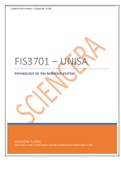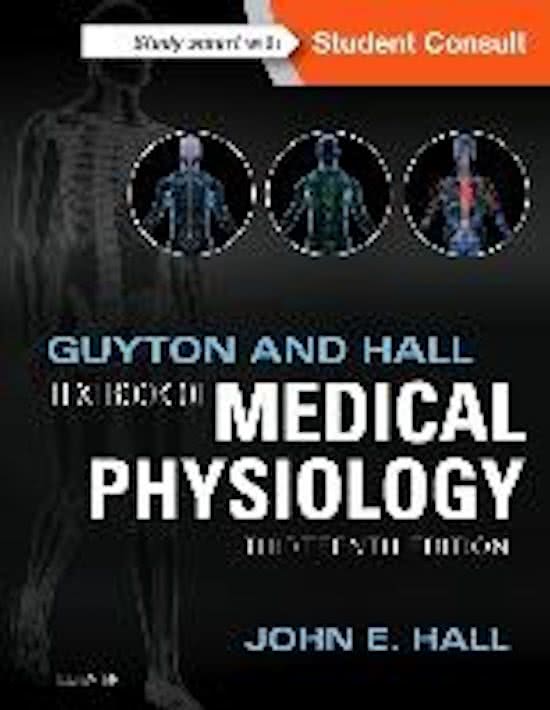COMPLIED BY R KHALID – SCIENCERA TUTOR
FIS3701 – UNISA
PHYSIOLOGY OF THE NERVOUS SYSTEM
SCIENCERA TUTORS
BOOK YOUR TUTOR: HTTPS://WWW.TEACHME2.COM/EN-ZA/TUTORS/RUBBIA-29398
,Question 1
1.1 Use an example to describe integrative function of the nervous system. (5)
The integrative function of the nervous system can be illustrated by the process of reflex arcs. For example, if you
accidentally touch a hot stove, your sensory neurons in your skin will detect the heat and send a signal to your
spinal cord. In the spinal cord, the sensory neuron will synapse with a motor neuron that sends a signal to your
muscles, causing them to contract and pull your hand away from the stove. This whole process happens
automatically and quickly, without conscious thought, thanks to the integrative function of the nervous system.
1.2 Mention 6 types of cells involved in the neural organization of the retina. (6)
• Photoreceptor cells (rods and cones) - detect light and convert it into neural signals.
• Bipolar cells - relay signals from photoreceptors to ganglion cells
• Ganglion cells - send signals out of the retina to the brain via the optic nerve.
• Horizontal cells - integrate signals from multiple photoreceptor cells to enhance contrast and sharpen
visual acuity.
• Amacrine cells - integrate signals from bipolar and ganglion cells to control sensitivity to light and
enhance motion detection.
• Müller cells - provide structural and metabolic support to other retinal cells and help maintain the
overall health of the retina.
Question 2
2.1 Acetylcholine is a small-molecule neurotransmitter of particular importance during motor control. Explain
how these molecules can be used and reused by examining the synthesis, release, and recycling of this
neurotransmitter. (10)
Acetylcholine is a neurotransmitter that is particularly important in the motor control of the body. Here is an
overview of how acetylcholine is synthesized, released, and recycled:
Synthesis: Acetylcholine is synthesized from choline and acetyl CoA by the enzyme choline acetyltransferase.
Choline is obtained from the diet or from recycling of membrane phospholipids. Acetyl CoA is a product of the
citric acid cycle in mitochondria.
Release: When an action potential reaches the end of a motor neuron, it triggers the opening of voltage-gated
calcium channels. The influx of calcium causes synaptic vesicles containing acetylcholine to fuse with the
presynaptic membrane and release acetylcholine into the synaptic cleft.
Recycling: After release, acetylcholine is rapidly removed from the synaptic cleft by the enzyme
acetylcholinesterase, which breaks it down into choline and acetate. The choline is taken back up into the
presynaptic neuron by a choline transporter protein, and the cycle begins again.
,This process of synthesis, release, and recycling ensures that there is a constant supply of acetylcholine available
for motor control.
2.2 In a tabular form, compare the two kinds of photoreceptors by focusing on their characteristics:
Photopigment, sensitivity, connection with ganglion cells, acuity, or illumination. (12)
Characteristic Rods Cones
Photopigment Rhodopsin Iodopsins (three types)
Sensitivity High in low light Low in low light, high in bright light
Connection with ganglion cells Many-to-one (pooling) One-to-one (separate pathways)
Acuity or illumination Low acuity, high illumination threshold High acuity, low illumination threshold
Rods contain the photopigment rhodopsin, which is sensitive to low levels of light, making them well-suited for
low-light conditions such as night vision. Rods are also more sensitive to light than cones, meaning they can
detect light at lower levels of illumination. However, because many rods converge onto a single bipolar cell, their
signal is pooled together and sent to a single ganglion cell, resulting in low spatial acuity.
Cones contain one of three types of photopigments, known as iodopsins, which are sensitive to different
wavelengths of light (blue, green, and red). Cones are less sensitive to light than rods, making them better suited
for bright conditions. Because each cone connects to a single bipolar cell, and each bipolar cell connects to a
single ganglion cell, the signal is not pooled, resulting in high spatial acuity.
Question 3
Answer the following insight questions:
3.1 Explain what can happen to a person if the brain blood flow is interrupted? (3)
If blood flow to the brain is interrupted, it can lead to a lack of oxygen and glucose supply to the brain cells,
which can result in brain cell death or brain damage. This can lead to a range of symptoms, including headache,
confusion, dizziness, loss of consciousness, seizures, and paralysis, depending on which part of the brain is
affected and the severity of the interruption.
3.2 Patient A is unable to make a sound, chew his food, and move her five fingers. Which parts of the brain
might be affected? (4)
, Patient A's inability to make a sound, chew their food, and move their fingers suggests that several different
areas of the brain may be affected. The inability to make a sound could indicate damage to the speech center,
which is in the left hemisphere of the brain in most people. The inability to chew could indicate damage to the
motor cortex, which controls voluntary movements of the muscles, including those involved in chewing. The
inability to move the fingers could indicate damage to the motor cortex or the somatosensory cortex, which
receives and processes sensory information from the skin and muscles.
3.3 Explain why sleep is such an important part of our daily lives. (5)
Sleep is an important part of our daily lives because it allows our brains and bodies to rest, recover, and
regenerate. During sleep, the brain consolidates memories, processes information, and removes waste products.
Sleep also allows the body to repair tissues, produce hormones, and strengthen the immune system. Chronic
sleep deprivation can lead to a range of health problems, including obesity, diabetes, heart disease, and
depression.
3.4 If nerve fibers only function by transmitting impulses throughout your nervous system, how is it that one
experiences different types of sensations? (5
While nerve fibers only function by transmitting impulses throughout the nervous system, the type of sensation
that one experiences depends on which sensory receptors are activated and the pattern of impulses generated
by those receptors. For example, different types of sensory receptors in the skin respond to different types of
stimuli, such as pressure, temperature, or pain. The pattern of impulses generated by these receptors is then
transmitted to the brain, where it is processed and interpreted as a specific type of sensation. The brain can also
integrate multiple types of sensory information to create more complex perceptions, such as the perception of a
hot, soft object.
Question 1
Give a brief explanation of the somatosensory areas. (5)
The somatosensory areas are regions of the brain that receive and process sensory information from the body,
including touch, pain, temperature, and proprioception (the sense of body position and movement). These areas
are primarily located in the parietal lobe of the cerebral cortex and are organized somatotopically, meaning that
different regions of the body are represented in specific areas of the somatosensory cortex. The processing of
sensory information in the somatosensory areas allows us to perceive and interpret sensory stimuli from the
external environment and our own bodies.
Question 2
Evaluate the role that the cerebellum plays in motor control, by using a real-life example (Other than the ones
provided in your textbooks). (10)





